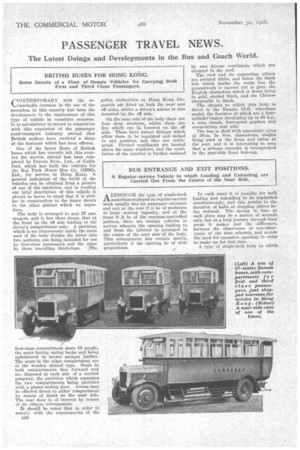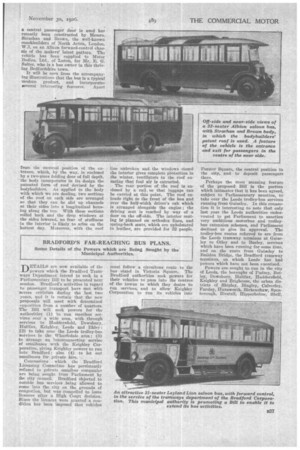BUS ENTRANCE AND EXIT POSITIONS.
Page 62

Page 63

If you've noticed an error in this article please click here to report it so we can fix it.
A Regular-service Vehicle in which Loading and Unloading are Carried Out From the Centre of the Near Side.
ALTHOUGII the type of single-deck motorbus employed on regular-service work usually has its passenger entrance and exit at the rear if it be of moderate or large seating capacity, and at the front if it be of the one-man-controlled pattern, there are certain vehicles in service wherein the opening leading to and from the interior is arranged in the centre of the near side of the body. This arrangement has certain merits, particularly if the opening be of wide proportions.
Iiis.uch cases it is possible for both loading and unloading to be conducted simultaneously, and this results in the duration of halts at stopping places being reduced. The saving in time at each place may be a matter of seconds only, but on a long journey through busy areas it makes just the difference, between the observance or non-observance of the time schedule and avoids the need for excessive speeding in order to make up for lost time.
A type of single-deck body in which first-class compartment seats 10 people, the seats having spring backs and being upholstered in brown antique leather. The seats in the other compartment are of the wooden slatted type. Seats in both compartments face forward and are disposed at each side of a central gangway, the partition which separates the two compartments being provided with a glazed sliding door. Access may be effected direct to either compartment by means of doors on the near side. The rear door is of interest by reas'on of its oblique arrangement.
It should be noted that in order to comply with the requirements of the 836 a central passenger door is used has recently been constructed by Messrs. Straehan and Brown, the well-known coed:thunders of North Acton, London, W.3, on an Albion forward-control chassis of the makers' latest pattern. The vehicle has been supplied to Motor Bodies, Ltd., of Luton, for Mr. E. G. Salter, who is a bus owner in this thriving Bedfordshire town.
It will be seen from the accompanying illustrations that the bus is a typical modern product, and incorporates several interesting features. Apart from the unusual position of the entrance, which, by the way, is enclosed by a two-piece folding door of full depth, the body incorporates in its design the patented form of roof devised by the bodybuilders. As applied to the body with which we are dealing, two sections of the roof on each side are arranged so that they can be slid up channels at their sides into a longitudinal housing along the top. With these sections rolled back and the drop windows at the sides lowered, no fear of stuffiness in the interior is likely to arise on the hottest day. Moreover, with the roof
line unbroken and the windows closed the interior gives complete protection in the winter, ventilators in the roof ensuring that foul air is extracted.
The rear portion of tfie roof is enclosed by a rail PO that luggage can be carried at this point. The roof extends right to the front of the bus and over the half-width driver's cab which is arranged alongside the engine ; the driving seat is reached by way of a door on the off-side. The interior seating iS planned on orthodox lines, and spring-back seats, which are upholstered in leather, are provided for 32 people.




















































































































